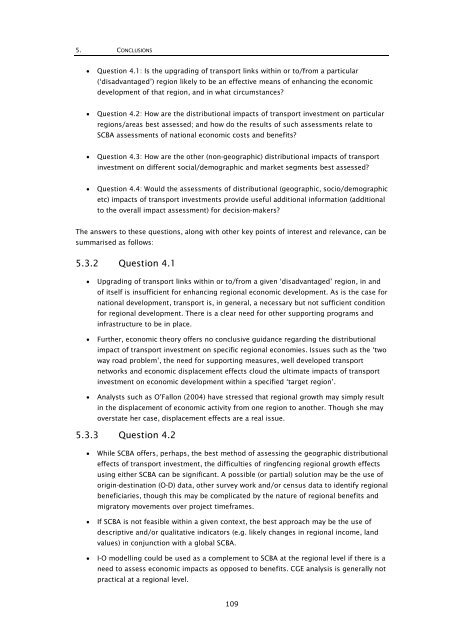Research 350 - NZ Transport Agency
Research 350 - NZ Transport Agency
Research 350 - NZ Transport Agency
Create successful ePaper yourself
Turn your PDF publications into a flip-book with our unique Google optimized e-Paper software.
5. CONCLUSIONS<br />
• Question 4.1: Is the upgrading of transport links within or to/from a particular<br />
(‘disadvantaged’) region likely to be an effective means of enhancing the economic<br />
development of that region, and in what circumstances?<br />
• Question 4.2: How are the distributional impacts of transport investment on particular<br />
regions/areas best assessed; and how do the results of such assessments relate to<br />
SCBA assessments of national economic costs and benefits?<br />
• Question 4.3: How are the other (non-geographic) distributional impacts of transport<br />
investment on different social/demographic and market segments best assessed?<br />
• Question 4.4: Would the assessments of distributional (geographic, socio/demographic<br />
etc) impacts of transport investments provide useful additional information (additional<br />
to the overall impact assessment) for decision-makers?<br />
The answers to these questions, along with other key points of interest and relevance, can be<br />
summarised as follows:<br />
5.3.2 Question 4.1<br />
• Upgrading of transport links within or to/from a given ‘disadvantaged’ region, in and<br />
of itself is insufficient for enhancing regional economic development. As is the case for<br />
national development, transport is, in general, a necessary but not sufficient condition<br />
for regional development. There is a clear need for other supporting programs and<br />
infrastructure to be in place.<br />
• Further, economic theory offers no conclusive guidance regarding the distributional<br />
impact of transport investment on specific regional economies. Issues such as the ‘two<br />
way road problem’, the need for supporting measures, well developed transport<br />
networks and economic displacement effects cloud the ultimate impacts of transport<br />
investment on economic development within a specified ‘target region’.<br />
• Analysts such as O’Fallon (2004) have stressed that regional growth may simply result<br />
in the displacement of economic activity from one region to another. Though she may<br />
overstate her case, displacement effects are a real issue.<br />
5.3.3 Question 4.2<br />
• While SCBA offers, perhaps, the best method of assessing the geographic distributional<br />
effects of transport investment, the difficulties of ringfencing regional growth effects<br />
using either SCBA can be significant. A possible (or partial) solution may be the use of<br />
origin-destination (O-D) data, other survey work and/or census data to identify regional<br />
beneficiaries, though this may be complicated by the nature of regional benefits and<br />
migratory movements over project timeframes.<br />
• If SCBA is not feasible within a given context, the best approach may be the use of<br />
descriptive and/or qualitative indicators (e.g. likely changes in regional income, land<br />
values) in conjunction with a global SCBA.<br />
• I-O modelling could be used as a complement to SCBA at the regional level if there is a<br />
need to assess economic impacts as opposed to benefits. CGE analysis is generally not<br />
practical at a regional level.<br />
109
















